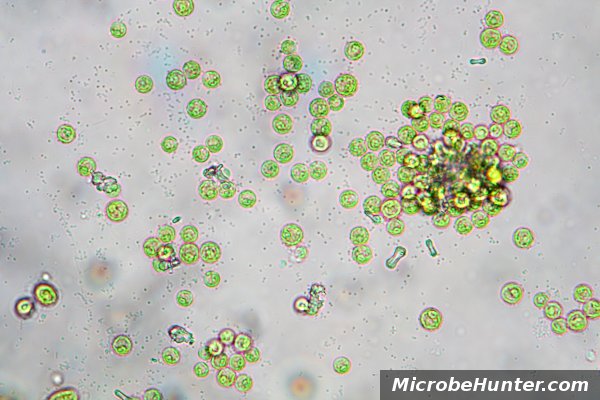
Over the past few years, I’ve met several students who wanted to see bacteria through the microscopes that we have at school. Unfortunately, these devices are not equipped with phase contrast optics. The transparent bacteria are therefore difficult (but not impossible) to see. The biggest draw-back, however, comes from a different source: some of the optics are a bit dirty, and the resolution and contrast therefore low. Some of the microscopes have been in operation for about 30 years, and actually I’m a bit surprised that they still work as well as they do. Regular maintenance is a must, but this is a different issue.
I therefore found it necessary to take a picture of some bacteria using my own microscope. It too does not have phase contrast optics. I’ve taken a water sample from the dish of a flower pot. The dish collected the excess water from the pot to prevent it from creating a mess. The pot and dish has been standing in the sun for a few days and was green, a clear sign that algae and other photosynthetic organisms are thriving. I think that I do not need to mention that the water which filtered through the soil is an ideal growth medium for algae (rich in nutrients etc.). I took some of the green slime and under the microscope, I could clearly see both green algae and bacteria, nicely next to each other (see picture).
Size of Bacteria and Algae
Bacteria and Algae belong to two different categories. Bacteria are prokaryotes, algae are eukaryotes. Prokaryotes are generally much smaller, about 1 micrometer (1/100 mm) in diameter, while eukaryotes can have a diameter of about 10-100 micrometers. These are averages and generalizations, of course. Some prokaryotes can also grow into long filaments, it really depends much on the type of organism. The picture illustrates this difference in size quite nicely with both cell types next to each other.
The picture should also make something else clear: Due to their small size, it is difficult to bring the bacteria into focus. They tend to either actively swim away, wiggle around or drift away as more and more water evaporates from the slide. Due to their green color, algae can also be much more easily identified. If you look closely, you can see that unlike the green algae, the bacteria lack structure on the inside and appear blurred. We are already at the limits of the microscope’s resolution. Other images show that the bacteria are brighter on the inside and darker on the outside. This is due to the refraction of light and an optical artifact. Opening the condenser aperture diaphragm would make the dark fringes disappear, but also more difficult to see the bacterial cells.





